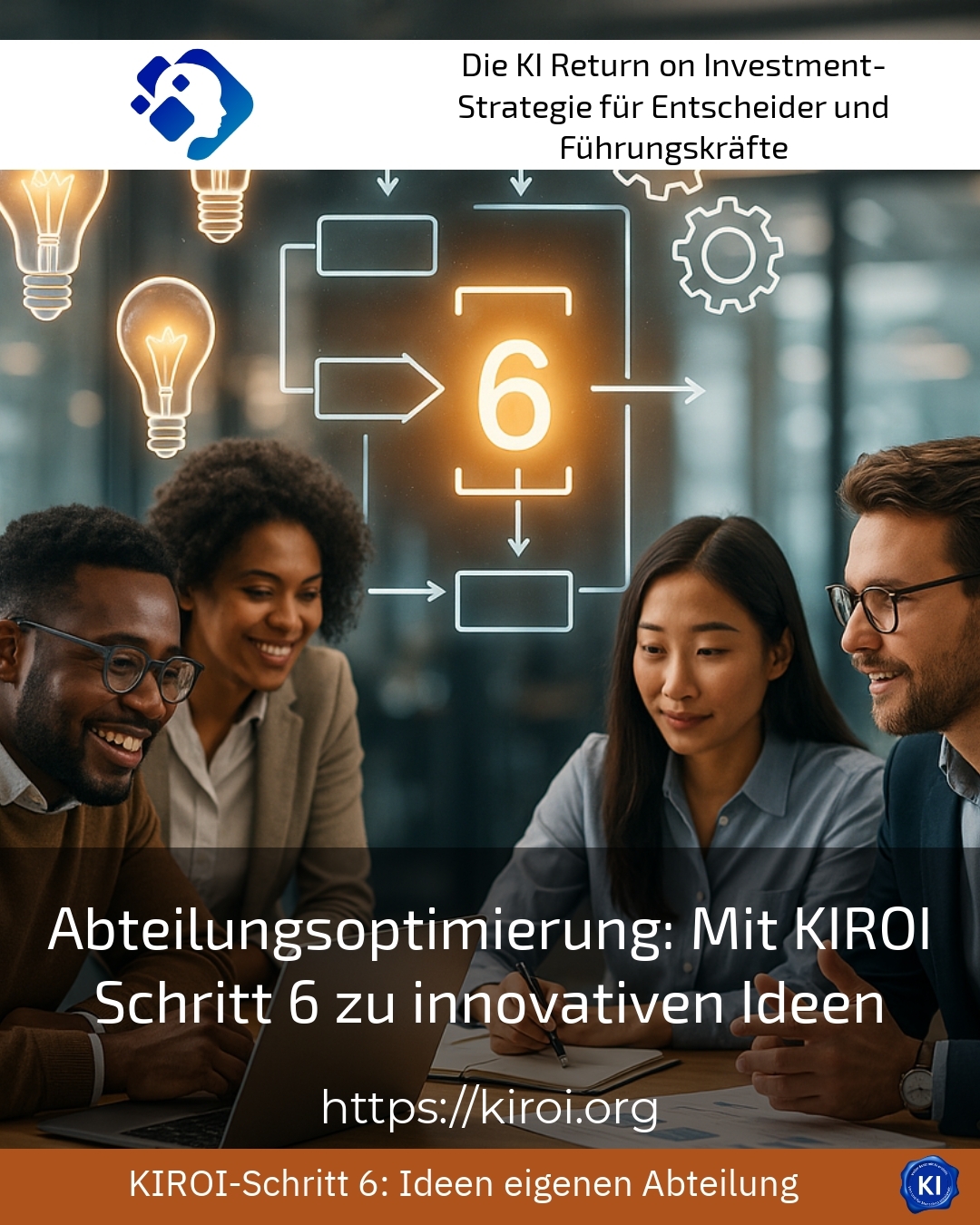Effective departmental optimisation offers companies the opportunity to streamline processes and use resources more efficiently. Particularly with the help of specialised support such as KIROI, innovative ideas can be systematically developed in step 6 to create sustainable added value. KIROI supports teams and managers in the creative generation of ideas and their practical implementation, which significantly promotes departmental optimisation in practice.
Department optimisation: Impulses for innovative ideas with KIROI
In many companies, departmental optimisation is the focus when it comes to improving processes and eliminating bottlenecks. KIROI focuses on step 6 - the idea and implementation of new solutions. This step is crucial in order to not only eliminate existing problems, but also to sustainably develop creative potential. The method supports teams in deriving concrete action steps from analytical findings.
In the automotive industry, for example, this support helps to simplify production processes by allowing employees to develop new approaches to reducing errors. In the IT sector, it has often been shown that complex software developments can be made more efficient through the targeted collection of ideas. Store teams in the retail sector also benefit from such creative impulses by optimising processes at the checkout and in the warehouse.
With KIROI, departmental optimisation is not just a technical process, but also always with the employees in mind. It is precisely the involvement of those involved that creates acceptance and motivates them to actively participate. This results in practical innovations that have a direct impact on productivity.
Practical examples of the use of KIROI for departmental optimisation
BEST PRACTICE with one customer (name hidden due to NDA contract) Here, KIROI supported the team of a production department in identifying unnecessary work steps. Together, creative solutions were developed that went beyond mere process streamlining, and the error rate was significantly reduced. This led to a noticeable increase in employee satisfaction and product quality.
In another case, KIROI supported the sales department of a medium-sized company. Joint workshops in step 6 resulted in new approaches to customer contact. These impulses improved response times and measurably increased closing rates.
A third example comes from the service sector, where support in the brainstorming process helped to optimise internal communication. This helped to minimise information loss and reduce waiting times for customers.
Methodical approaches for successful department optimisation with KIROI
The KIROI methodology is based on proven elements such as the continuous improvement process (CIP) and creative techniques. The aim is to establish step 6 as an integral part of the optimisation cycle. This means a clear structure for idea generation, evaluation and implementation.
A key advantage is the combination of analysis tools with creative moderation formats. This not only generates innovative ideas, but also directly realisable measures. The integration of employees from different departments promotes the diversity of suggestions and supports holistic departmental optimisation.
In addition to KIROI, many companies are also familiar with methods such as lean management, Six Sigma or the morphological box, which complement each other well when used together. Here, KIROI can focus on idea development and support the innovation process, which is often neglected in the other methods.
Actionable tips for optimising your department
For sustainable departmental optimisation, we recommend implementing step 6 as follows:
- Early involvement of all relevant employees in order to gather broad perspectives.
- Moderated workshops with clear objectives for developing and prioritising ideas.
- Combining analytical findings with creative techniques such as brainstorming or the 635 method.
- Testing ideas on a small scale in order to test their practicality and make adjustments quickly.
- Documentation and communication of the results in order to promote acceptance and create transparency.
Companies in the mechanical engineering sector often report that this approach allows manufacturing processes to be organised more smoothly in no time at all. In the healthcare sector, we often see that structured brainstorming leads to better patient care and more efficient processes. The financial sector also benefits from improved data flows and faster decision-making.
My analysis
The importance of departmental optimisation is constantly growing as companies face increasingly complex challenges. With KIROI, step 6 in particular - the process of idea generation and implementation - can be effectively supported. The support makes it possible to generate sustainable and practical innovations that are supported by the involvement of employees.
This creates a continuous improvement process that goes beyond simply increasing efficiency and also increases the motivation of the teams. Innovations thus become an integral part of the company's development. Companies that integrate KIROI into their departmental optimisation report increased competitiveness and better adaptability to market changes.
Further links from the text above:
Process optimisation: definition, objectives, phases, procedure (IPH Hannover)
Process optimisation: How it works + practical example (Personio)
Process optimisation: Everything about the topic (Lexware)
Process optimisation: definition, methods & implementation (Reese GmbH)
Process optimisation: definition, methods, examples (StepStone)
For more information and if you have any questions, please contact Contact us or read more blog posts on the topic Artificial intelligence here.















